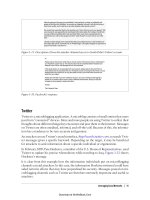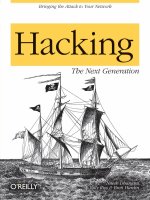Hacking: The Next Generation P2
Bạn đang xem bản rút gọn của tài liệu. Xem và tải ngay bản đầy đủ của tài liệu tại đây (1017.25 KB, 20 trang )
Figure 1-10. Facebook’s response
Twitter
Twitter is
a microblogging application. A microblog consists of small entries that users
post from “connected” devices. More and more people are using Twitter to collect their
thoughts about different things they encounter and post them to the Internet. Messages
on Twitter are often unedited, informal, and off-the-cuff. Because of this, the informa-
tion has a tendency to be very accurate and genuine.
An attacker can use Twitter’s search interface, , to search Twit-
ter messages given a specific keyword. Depending on the target, it may be beneficial
for attackers to seek information about a specific individual or organization.
In February 2009, Pete Hoekstra, a member of the U.S. House of Representatives, used
Twitter to update his precise whereabouts while traveling to Iraq. Figure 1-12 shows
Hoekstra’s message.
It is clear from this example how the information individuals put on microblogging
channels can aid attackers. In this case, the information Hoekstra twittered could have
aided terrorist efforts that may have jeopardized his security. Messages posted on mi-
croblogging channels such as Twitter are therefore extremely important and useful to
attackers.
Figure 1-11. Description of how the attacker obtained access to Sarah Palin’s Yahoo! account
Leveraging Social Networks | 15
Download at WoWeBook.Com
For more information on the Pete Hoekstra incident, see “Pete Hoekstra
Uses
Twitter
to Post from Iraq about Secret Trip” at ia
mouse.org/news/2009/02/pete-hoekstra-twitter-iraq.php.
Tracking Employees
Attackers do not necessarily limit their attacks to organizations. Often, the attacks are
aimed at specific employees and business units of the target organization. The human
factor is still the weakest part of the organization.
First things first: attackers need to gather employee lists and then correlate attack vec-
tors to them. In doing so, attackers have a better chance of successfully entering the
target organization.
A critical step for attackers is to gather a target list of employees. This list will often
contain employee names, personal and work email addresses, home addresses, work
and home phone numbers, and some interesting notes about the employees.
The information contained in such an employee list can have multiple uses. For ex-
ample, certain information about an employee may suggest that the best attack method
is social engineering through intimidation. Another employee’s profile may suggest she
is particularly vulnerable to clicking links from emails received from social applications.
Email Harvesting with theHarvester
One of the first steps an attacker needs to take is to gather the corporate email addresses
of employees. Attackers do this by using search engines or by crawling the corporate
Figure 1-12. Pete Hoekstra’s Twitter message
16 | Chapter 1: Intelligence Gathering: Peering Through the Windows to Your Organization
Download at WoWeBook.Com
website. In addition, they can search forums, looking for email addresses ending in the
target domain.
Obtaining email addresses provides a starting point for an attacker; once he has the
email addresses, he can research the employees in more depth.
theHarvester, also known as goog-mail.py, is a tool for enumerating email addresses
from a target domain using these methods. You can configure theHarvester to use
Google or the MSN search engine, as well as attempt enumeration on PGP servers and
LinkedIn.com. The following example demonstrates how to use theHarvester.py to find
email addresses belonging to example.com using Google as the search engine:
$ python theHarvester.py -d example.com -b google -l 1000
*************************************
*TheHarvester Ver. 1.4 *
*Coded by laramies *
*Edge-Security Research *
* *
*************************************
Searching for example.com in google :
========================================
Total results: 326000000
Limit: 1000
Searching results: 0
Searching results: 100
Searching results: 200
Searching results: 300
Searching results: 400
Searching results: 500
Searching results: 600
Searching results: 700
Searching results: 800
Searching results: 900
Accounts found:
====================
====================
Total results: 5
theHarvester is available on BackTrack 3 under the /pentest/enumera-
tion/google directory
and is named goog-mail.py. It is also available for
download at />Tracking Employees | 17
Download at WoWeBook.Com
Resumés
Using online search engines, attackers can search for resumés containing sensitive
information. The amount of “sensitive” information contained in a resumé can be sub-
stantial. Job seekers will often include information in their resumés that could be con-
sidered sensitive and therefore could be useful to an attacker.
The majority of people building resumés don’t realize attackers can data-mine the
information they include, and therefore will often include details about projects they
are currently working on. These details can range from benign information or general
knowledge to information that is intended for an internal audience only.
Again, an attacker can use Google to search for resumés containing the name of the
target organization. For example, this search query will return Microsoft Word resumés
that contain the phrase “current projects”:
resume filetype:doc "current projects"
Searches such as this turn up hundreds of results. Searching for current and previous
employees of the target organization can reveal information that is important to an
attacker. Information from resumés can:
• Reveal programs, databases, and operating systems that are used internally. Sys-
tems include SAP, MySQL, Oracle, Unix, and Windows. This information may
include version numbers.
• Reveal previous and current projects. Attackers can search for other resumés that
have similar project names to attempt to locate other team members.
• Allow attackers to link employees who worked on projects together, aiding an
attacker in identifying social networks.
• Reveal internal details of projects.
• Reveal home addresses and phone numbers of current employees that can be used
in social engineering attacks.
The projects listed in the sample resumé illustrated in Figure 1-13 include competitive
products currently in development, information about SAP integration, and a hybrid
engine purchased by Boeing in September 2006.
18 | Chapter 1: Intelligence Gathering: Peering Through the Windows to Your Organization
Download at WoWeBook.Com
Figure 1-13. Resumé with information that could potentially help an attacker
Job Postings
In addition
to resumés, job postings can lead attackers to useful information. Job post-
ings are often found on corporate websites or through job search sites (for example,
Monster.com). Some job postings contain information such as hiring managers’ names,
corporate email addresses, or additional information that can aid attackers in tracking
down employees.
Using information gathered from a simple job posting, along with ideas we presented
earlier in the chapter, we will demonstrate how we were able to track down a target
employee. Our first step was to search a job posting site looking for hiring managers.
After searching Monster.com for a hiring manager from the target organization, we
acquired the email address shown in Figure 1-14.
Figure 1-14. Job posting listing the hiring manager’s email address
Once we
obtained the email address, we used Google to track down information on
the hiring manager, as illustrated in Figure 1-15. The information we obtained identi-
fied the hiring manager’s name and work phone number. We found this information
on the company’s corporate website.
Tracking Employees | 19
Download at WoWeBook.Com
Figure 1-15. A Google search revealing the hiring manager’s full name and work extension
Now we had a work number and extension. What other information can we dig up?
Using LinkedIn,
we searched for the hiring manager along with the name of the or-
ganization. We successfully identified the hiring manager’s profile, which gave us more
information about her. Figure 1-16 is a screenshot of the hiring manager’s LinkedIn
page, which contains a wealth of information that we could use for nefarious purposes.
Figure 1-16. The hiring manager’s LinkedIn profile
Now we
have professional information about the target. Can we dig further to identify
other personal information? Can we use this information to intimidate or blackmail
the hiring manager?
Assume that we browse to some social application sites and use the hiring manager’s
name as a search term. We can limit the results based on the geographic location listed
in the target’s LinkedIn profile. We can use additional information to limit results,
including the target’s age and occupation, and even her social contacts. Figure 1-17
shows the target’s MySpace profile.
20 | Chapter 1: Intelligence Gathering: Peering Through the Windows to Your Organization
Download at WoWeBook.Com
Figure 1-17. The hiring manager’s MySpace page
This demonstrates
the impact that a few pieces of information can have. Using that
information, we were able to obtain additional information about the victim and her
organization. Obviously, job postings can lead attackers in identifying key people, and
give them a starting point for an attack.
Google Calendar
Attackers can use Google Calendar, located at , to find in-
formation about companies and their employees. Using a valid Google account, an
attacker can search through public calendars. Most individuals are aware that public
calendars shouldn’t contain sensitive or confidential information. But people often
forget this fact after they have made their calendar public. Information in public cal-
endars can include internal company deadlines, internal projects, and even dial-in
information.
Figure 1-18 shows the dial-in number and code required to attend an IBO teleconfer-
ence. Attackers can use this public information to call in and “overhear” the conference
call.
Figure 1-18. Dial-in information obtained from calendar.google.com
Figure 1-19
shows another conference call, but outlines more detail about the call. The
description states that three vendors will be making their final pitches to the organiza-
tion. The description goes on to say that the company is not informing the vendors
about the other phone calls to avoid having them “listen in” on their competition’s
calls. Why did someone put this in his public calendar for the world to see? It is clear
how this may aid an attacker and a competitor.
Tracking Employees | 21
Download at WoWeBook.Com
What Information Is Important?
What kind
of information is important to an attacker and what isn’t? All information
that an attacker can find can be used for some purpose. From the attacker’s perspective,
all information is important. Some information can be more critical than other infor-
mation. Information that could be deemed critical for an attacker to have would
include:
• An employee’s personally identifiable information (PII), such as work and home
phone numbers, work and home addresses, criminal history, Social Security num-
bers, and credit reports
• Network layouts, including the number of web servers and mail servers, their lo-
cations, and the software versions they run
• Company files, including database files, network diagrams, internal papers and
documentation, spreadsheets, and so forth
• Company information such as mergers and acquisitions, business partners, hosting
services, and so forth
• Organizational information, including organizational charts detailing the corpo-
rate structure of who reports to whom
• Work interactions detailing such information as who gets along at the office, how
often direct reports communicate with their managers, how often managers com-
municate with their subordinates, how they communicate (e.g., via email, phone,
BlackBerry), and so forth
The information outlined here can be public or private. Attackers who have done their
preliminary research are rewarded greatly. All of the information obtained during re-
Figure 1-19. Dial-in information regarding vendor calls
22 | Chapter 1: Intelligence Gathering: Peering Through the Windows to Your Organization
Download at WoWeBook.Com









